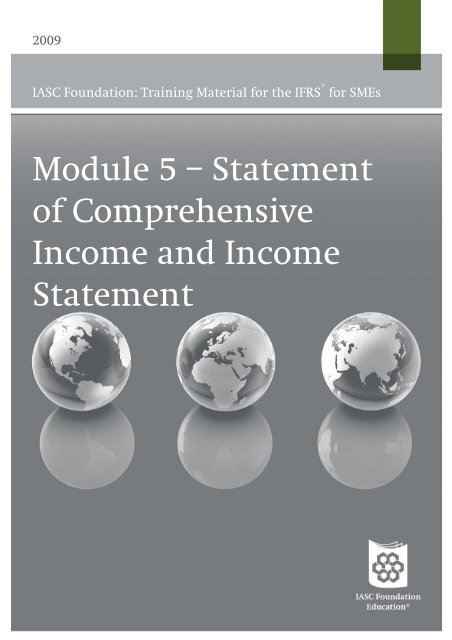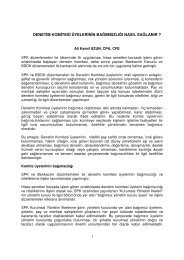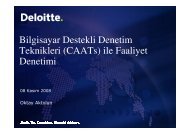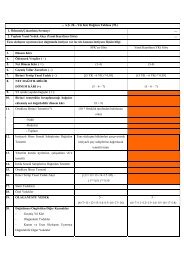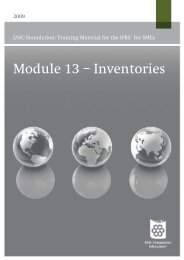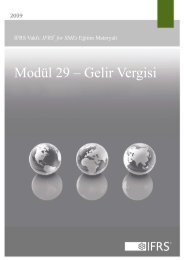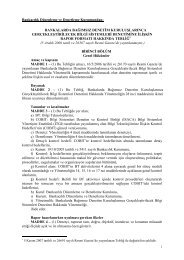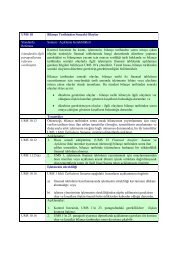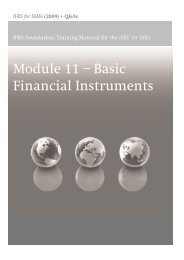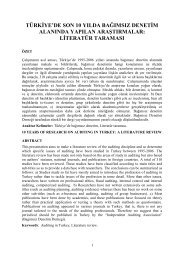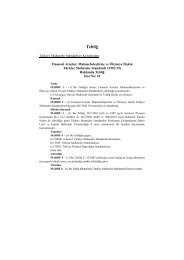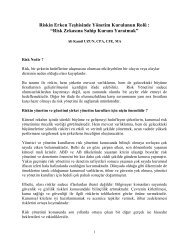Module 5 â Statement of Comprehensive Income and ... - Focus IFRS
Module 5 â Statement of Comprehensive Income and ... - Focus IFRS
Module 5 â Statement of Comprehensive Income and ... - Focus IFRS
Create successful ePaper yourself
Turn your PDF publications into a flip-book with our unique Google optimized e-Paper software.
2009IASC Foundation: Training Material for the <strong>IFRS</strong> ® for SMEs<strong>Module</strong> 5 – <strong>Statement</strong><strong>of</strong> <strong>Comprehensive</strong><strong>Income</strong> <strong>and</strong> <strong>Income</strong><strong>Statement</strong>
International Accounting St<strong>and</strong>ards Committee Foundation®30 Cannon Street | London EC4M 6XH | United KingdomTelephone: +44 (0)20 7246 6410 | Fax: +44 (0)20 7246 6411 | Email: iasb@iasb.orgPublications Telephone: +44 (0)20 7332 2730 | Publications Fax: +44 (0)20 7332 2749Publications Email: publications@iasb.org | Web: www.iasb.orgCopyright © 2010 IASCF®Right <strong>of</strong> useAlthough the International Accounting St<strong>and</strong>ards Committee (IASC) Foundation encourages you to use this trainingmaterial, as a whole or in part, for educational purposes, you must do so in accordance with the copyright termsbelow.Please note that the use <strong>of</strong> this module <strong>of</strong> training material is not subject to the payment <strong>of</strong> a fee.Copyright noticeAll rights, including copyright, in the content <strong>of</strong> this module <strong>of</strong> training material are owned or controlled by theIASC Foundation.Unless you are reproducing the training module in whole or in part to be used in a st<strong>and</strong>-alone document, you mustnot use or reproduce, or allow anyone else to use or reproduce, any trade marks that appear on or in the trainingmaterial. For the avoidance <strong>of</strong> any doubt, you must not use or reproduce any trade mark that appears on or in thetraining material if you are using all or part <strong>of</strong> the training materials to incorporate into your own documentation.These trade marks include, but are not limited to, the IASC Foundation <strong>and</strong> IASB names <strong>and</strong> logos.When you copy any extract, in whole or in part, from a module <strong>of</strong> the IASC Foundation training material, you mustensure that your documentation includes a copyright acknowledgement that the IASC Foundation is the source <strong>of</strong>your training material. You must ensure that any extract you are copying from the IASC Foundation trainingmaterial is reproduced accurately <strong>and</strong> is not used in a misleading context. Any other proposed use <strong>of</strong> the IASCFoundation training materials will require a licence in writing.Please address publication <strong>and</strong> copyright matters to:IASC Foundation Publications Department30 Cannon Street London EC4M 6XH United KingdomTelephone: +44 (0)20 7332 2730 Fax: +44 (0)20 7332 7249Email:publications@iasb.org Web: www.iasb.orgThe IASC Foundation, the authors <strong>and</strong> the publishers do not accept responsibility for loss caused to any person whoacts or refrains from acting in reliance on the material in this publication, whether such loss is caused by negligenceor otherwise.The IASB logo/the IASCF logo/‘Hexagon Device’, ‘IASC Foundation Education logo’, IASC Foundation’, ‘e<strong>IFRS</strong>’, ‘IAS’,‘IASB’, ‘IASC’, ‘IASCF’, ‘IASC Foundation Education’ ‘IASs’, ‘IFRIC’, ‘<strong>IFRS</strong>’, ‘<strong>IFRS</strong>s’, ‘International Accounting St<strong>and</strong>ards’,‘International Financial Reporting St<strong>and</strong>ards’ <strong>and</strong> ‘SIC’ are Trade Marks <strong>of</strong> the IASC Foundation.
ContentsINTRODUCTION __________________________________________________________ 1Learning objectives ________________________________________________________ 1<strong>IFRS</strong> for SMEs ____________________________________________________________ 2Introduction to the requirements_______________________________________________ 2REQUIREMENTS AND EXAMPLES ___________________________________________ 3Scope <strong>of</strong> this section _______________________________________________________ 3Presentation <strong>of</strong> total comprehensive income _____________________________________ 4Analysis <strong>of</strong> expenses ______________________________________________________ 14SIGNIFICANT ESTIMATES AND OTHER JUDGEMENTS _________________________ 18COMPARISON WITH FULL <strong>IFRS</strong>s ___________________________________________ 19TEST YOUR KNOWLEDGE ________________________________________________ 20APPLY YOUR KNOWLEDGE _______________________________________________ 24Case study 1 ____________________________________________________________ 24Answer to case study 1 ____________________________________________________ 26Case study 2 ____________________________________________________________ 31Answer to case study 2 ____________________________________________________ 33IASC Foundation: Training Material for the <strong>IFRS</strong> ® for SMEs (version 2010-1)iv
<strong>Module</strong> 5 – <strong>Statement</strong> <strong>of</strong> <strong>Comprehensive</strong> <strong>Income</strong><strong>and</strong> <strong>Income</strong> <strong>Statement</strong>This training material has been prepared by IASC Foundation education staff <strong>and</strong> hasnot been approved by the International Accounting St<strong>and</strong>ards Board (IASB).The accounting requirements applicable to small <strong>and</strong> medium-sized entities (SMEs) areset out in the International Financial Reporting St<strong>and</strong>ard (<strong>IFRS</strong>) for SMEs, which wasissued by the IASB in July 2009.INTRODUCTIONThis module focuses on the requirements for the presentation <strong>of</strong> the statement <strong>of</strong>comprehensive income <strong>and</strong> the income statement in accordance with Section 5 <strong>Statement</strong> <strong>of</strong><strong>Comprehensive</strong> <strong>Income</strong> <strong>and</strong> <strong>Income</strong> <strong>Statement</strong> <strong>of</strong> the <strong>IFRS</strong> for SMEs.Section 3 Financial <strong>Statement</strong> Presentation sets out general presentation requirements <strong>and</strong>Sections 4–8 focus on the requirements for the presentation <strong>of</strong> the financial statements.This module introduces the learner to the statement <strong>of</strong> comprehensive income <strong>and</strong> theincome statement, guides the learner through the <strong>of</strong>ficial text <strong>of</strong> the requirements forpresenting those statements, develops the learner’s underst<strong>and</strong>ing <strong>of</strong> the requirementsthrough the use <strong>of</strong> examples <strong>and</strong> indicates significant judgements that are requiredpresenting those statements. Furthermore, the module includes questions designed to test thelearner’s knowledge <strong>of</strong> the requirements <strong>and</strong> case studies to develop the learner’s ability topresent those statements in accordance with the <strong>IFRS</strong> for SMEs.Learning objectivesUpon successful completion <strong>of</strong> this module you should know the financial reportingrequirements for the presentation <strong>of</strong> the statement <strong>of</strong> comprehensive income <strong>and</strong> the incomestatement in accordance with the <strong>IFRS</strong> for SMEs. Furthermore, through the completion <strong>of</strong> casestudies that simulate aspects <strong>of</strong> the real world application <strong>of</strong> that knowledge, you should haveenhanced your ability to present those statements in accordance with the <strong>IFRS</strong> for SMEs.In particular, in the context <strong>of</strong> the <strong>IFRS</strong> for SMEs, you should:underst<strong>and</strong> the choice between the single-statement approach <strong>and</strong> the two-statementapproachbe able to present a statement <strong>of</strong> comprehensive incomebe able to present an income statementknow what items <strong>of</strong> income <strong>and</strong> expenses are presented as other comprehensive incomebe able to identify a discontinued operationbe able to analyse expenses by nature <strong>and</strong> by function.IASC Foundation: Training Material for the <strong>IFRS</strong>® for SMEs 1
<strong>Module</strong> 5 – <strong>Statement</strong> <strong>of</strong> <strong>Comprehensive</strong> <strong>Income</strong><strong>and</strong> <strong>Income</strong> <strong>Statement</strong><strong>IFRS</strong> for SMEsThe <strong>IFRS</strong> for SMEs is intended to apply to the general purpose financial statements <strong>of</strong> entitiesthat do not have public accountability (see Section 1 Small <strong>and</strong> Medium-sized Entities).The <strong>IFRS</strong> for SMEs includes m<strong>and</strong>atory requirements <strong>and</strong> other material (non-m<strong>and</strong>atory) that ispublished with it.The material that is not m<strong>and</strong>atory includes:a preface, which provides a general introduction to the <strong>IFRS</strong> for SMEs <strong>and</strong> explains itspurpose, structure <strong>and</strong> authority.implementation guidance that includes illustrative financial statements <strong>and</strong> a disclosurechecklist.the Basis for Conclusions, which summarises the IASB’s main considerations in reachingits conclusions in the <strong>IFRS</strong> for SMEs.the dissenting opinion <strong>of</strong> an IASB member who did not agree with the publication <strong>of</strong> the<strong>IFRS</strong> for SMEs.In the <strong>IFRS</strong> for SMEs the Glossary is part <strong>of</strong> the m<strong>and</strong>atory requirements.In the <strong>IFRS</strong> for SMEs there are appendices in Section 21 Provisions <strong>and</strong> Contingencies, Section 22Liabilities <strong>and</strong> Equity <strong>and</strong> Section 23 Revenue. Those appendices are non-m<strong>and</strong>atory guidance.Introduction to the requirementsThe objective <strong>of</strong> general purpose financial statements <strong>of</strong> a small or medium-sized entity is toprovide information about the entity’s financial position, performance <strong>and</strong> cash flows that isuseful for economic decision-making by a broad range <strong>of</strong> users who are not in a position todem<strong>and</strong> reports tailored to meet their particular information needs.Section 3 Financial <strong>Statement</strong> Presentation prescribes general requirements for the presentation <strong>of</strong>financial statements.Section 5 <strong>Statement</strong> <strong>of</strong> <strong>Comprehensive</strong> <strong>Income</strong> <strong>and</strong> <strong>Income</strong> <strong>Statement</strong> specifies requirements forpresenting an entity’s financial performance for the period. It provides an accounting policychoice between presenting total comprehensive income in a single statement or in twoseparate statements. It specifies line items to be presented in those statements <strong>and</strong> prohibitsthe presentation or description <strong>of</strong> any items <strong>of</strong> income or expense as ‘extraordinary items’. Italso requires presentation <strong>of</strong> an analysis <strong>of</strong> expenses using a classification based on either thenature <strong>of</strong> expenses or the function <strong>of</strong> expenses within the entity, whichever providesinformation that is reliable <strong>and</strong> more relevant.IASC Foundation: Training Material for the <strong>IFRS</strong> ® for SMEs (version 2010-1) 2
<strong>Module</strong> 5 – <strong>Statement</strong> <strong>of</strong> <strong>Comprehensive</strong> <strong>Income</strong><strong>and</strong> <strong>Income</strong> <strong>Statement</strong>REQUIREMENTS AND EXAMPLESThe contents <strong>of</strong> Section 5 <strong>Statement</strong> <strong>of</strong> <strong>Comprehensive</strong> <strong>Income</strong> <strong>and</strong> <strong>Income</strong> <strong>Statement</strong> <strong>of</strong> the<strong>IFRS</strong> for SMEs are set out below <strong>and</strong> shaded grey. Terms defined in the Glossary <strong>of</strong> the<strong>IFRS</strong> for SMEs are also part <strong>of</strong> the requirements. Those terms are in bold type the first timethey appear in the text <strong>of</strong> Section 5. The notes <strong>and</strong> examples inserted by the IASC Foundationeducation staff are not shaded. The insertions made by the staff do not form part <strong>of</strong> the<strong>IFRS</strong> for SMEs <strong>and</strong> have not been approved by the IASB.Scope <strong>of</strong> this section5.1 This section requires an entity to present its total comprehensive income for a period—ie its financial performance for the period―in one or two financial statements. It setsout the information that is to be presented in those statements <strong>and</strong> how to present it.NotesPr<strong>of</strong>it or loss (sometimes called net income) is frequently used as a measure <strong>of</strong>performance or as the basis for other measures, such as return on investment orearnings per share. The elements directly related to the measurement <strong>of</strong> pr<strong>of</strong>it areincome <strong>and</strong> expenses. Paragraph 5.4(b) specifies three items <strong>of</strong> income <strong>and</strong> expensesthat are recognised outside <strong>of</strong> pr<strong>of</strong>it or loss (ie in other comprehensive income). Thissection specifies the presentation <strong>of</strong> an entity’s income <strong>and</strong> expenses. Other sections <strong>of</strong>the <strong>IFRS</strong> for SMEs specify requirements for recognising <strong>and</strong> measuring income <strong>and</strong>expenses.<strong>Income</strong> is increases in economic benefits during the accounting period in the form <strong>of</strong>inflows or enhancements <strong>of</strong> assets or decreases <strong>of</strong> liabilities that result in increases inequity, other than those relating to contributions from equity participants.Expenses are decreases in economic benefits during the accounting period in the form<strong>of</strong> outflows or depletions <strong>of</strong> assets or incurrences <strong>of</strong> liabilities that result in decreasesin equity, other than those relating to distributions to equity participants.Distinguishing between items <strong>of</strong> income <strong>and</strong> expense <strong>and</strong> combining them in differentways also permits several measures <strong>of</strong> entity performance to be displayed. These havediffering degrees <strong>of</strong> inclusiveness. An entity may disclose additional line items,headings <strong>and</strong> subtotals in its financial performance statements (eg as additionalsubtotals it could display gross pr<strong>of</strong>it, pr<strong>of</strong>it or loss from ordinary activities beforetaxation <strong>and</strong> pr<strong>of</strong>it before tax) when such presentation is relevant to underst<strong>and</strong>ingthe entity’s financial performance.IASC Foundation: Training Material for the <strong>IFRS</strong> ® for SMEs (version 2010-1) 3
<strong>Module</strong> 5 – <strong>Statement</strong> <strong>of</strong> <strong>Comprehensive</strong> <strong>Income</strong><strong>and</strong> <strong>Income</strong> <strong>Statement</strong>Presentation <strong>of</strong> total comprehensive income5.2 An entity shall present its total comprehensive income for a period either:(a) in a single statement <strong>of</strong> comprehensive income, in which case the statement <strong>of</strong>comprehensive income presents all items <strong>of</strong> income <strong>and</strong> expense recognised in theperiod, or [Refer: paragraphs 5.4–5.6 <strong>and</strong> 5.8–5.10](b) in two statements—an income statement <strong>and</strong> a statement <strong>of</strong> comprehensiveincome—in which case the income statement presents all items <strong>of</strong> income <strong>and</strong>expense recognised in the period except those that are recognised in totalcomprehensive income outside <strong>of</strong> pr<strong>of</strong>it or loss as permitted or required by this<strong>IFRS</strong>. [Refer: paragraphs 5.7–5.10]NotesThe choice presented in paragraph 5.2 (ie single-statement approach or atwo-statement approach) is an accounting policy choice. Paragraph 10.7 requires anentity to select <strong>and</strong> apply its accounting policies consistently. Moreover, an entitycannot change its accounting policy unless the change would result in its financialstatements providing reliable <strong>and</strong> more relevant information about the effects <strong>of</strong>transactions, other events or conditions on the entity’s financial position, financialperformance or cash flows (see paragraph 10.8(b)).5.3 A change from the single-statement approach to the two-statement approach, or viceversa, is a change in accounting policy to which Section 10 Accounting Policies,Estimates <strong>and</strong> Errors applies.NotesIn accordance with Section 10 comparative figures are restated in financial statementsfollowing a change from a single-statement approach to a two-statement approach, orvice versa.Single-statement approach5.4 Under the single-statement approach, the statement <strong>of</strong> comprehensive income shallinclude all items <strong>of</strong> income <strong>and</strong> expense recognised in a period unless this <strong>IFRS</strong> requiresotherwise. This <strong>IFRS</strong> provides different treatment for the following circumstances:(a) The effects <strong>of</strong> corrections <strong>of</strong> errors <strong>and</strong> changes in accounting policies arepresented as retrospective adjustments <strong>of</strong> prior periods rather than as part <strong>of</strong> pr<strong>of</strong>it orloss in the period in which they arise (see Section 10).[Refer: paragraph 5.8]IASC Foundation: Training Material for the <strong>IFRS</strong> ® for SMEs (version 2010-1) 4
<strong>Module</strong> 5 – <strong>Statement</strong> <strong>of</strong> <strong>Comprehensive</strong> <strong>Income</strong><strong>and</strong> <strong>Income</strong> <strong>Statement</strong>Example – retrospective adjustmentsEx 1 During 20X7, after the entity’s 20X6 financial statements were approved for issue,the entity discovered a computational error in the calculation <strong>of</strong> depreciationexpense for the year ended 31 December 20X6 (ie pr<strong>of</strong>it before tax for the yearended 31 December 20X6 is overstated by CU7,800, with a resultant CU1,950overstatement <strong>of</strong> income tax expense).The entity’s statement <strong>of</strong> comprehensive income for the year ended 31 December 20X7could be presented as follows:An entity – statement <strong>of</strong> comprehensive income for the year ended 31 December 20X720X7 20X6RestatedCUCURevenue 680,000 525,000Other income 54,000 32,000Changes in inventories <strong>of</strong> finished goods <strong>and</strong> work in progress 23,520 25,620Raw material <strong>and</strong> consumables used (428,000) (299,800)Employee benefits expense (78,000) (76,000)Depreciation <strong>and</strong> amortisation expense (20X6: previously stated CU21,200) (25,600) (29,000)Impairment <strong>of</strong> property, plant <strong>and</strong> equipment – (3,200)Other expenses (4,500) (3,250)Finance costs (22,300) (19,700)Share <strong>of</strong> pr<strong>of</strong>it <strong>of</strong> associates 42,100 38,560Pr<strong>of</strong>it before tax (20X6: previously stated CU198,030) 241,220 190,230<strong>Income</strong> tax expense (20X6: previously stated CU49,508) (60,305) (47,558)Pr<strong>of</strong>it/Total comprehensive income for the year (20X6: previouslystated CU148,522) 180,915 142,672(b) Three types <strong>of</strong> other comprehensive income are recognised as part <strong>of</strong> totalcomprehensive income, outside <strong>of</strong> pr<strong>of</strong>it or loss, when they arise:(i) some gains <strong>and</strong> losses arising on translating the financial statements <strong>of</strong> aforeign operation (see Section 30 Foreign Currency Translation).(ii) some actuarial gains <strong>and</strong> losses (see Section 28 Employee Benefits).(iii) some changes in fair values <strong>of</strong> hedging instruments (see Section 12 OtherFinancial Instruments Issues).IASC Foundation: Training Material for the <strong>IFRS</strong> ® for SMEs (version 2010-1) 5
<strong>Module</strong> 5 – <strong>Statement</strong> <strong>of</strong> <strong>Comprehensive</strong> <strong>Income</strong><strong>and</strong> <strong>Income</strong> <strong>Statement</strong>Example – other comprehensive incomeEx 2 The statement <strong>of</strong> comprehensive income <strong>of</strong> an entity could be presented in a singlestatement as follows:An entity’s statement <strong>of</strong> comprehensive income for the year ended 31 December 20X8CUCURevenue 645,000 499,500Cost <strong>of</strong> sales (500,000) (400,000)Distribution costs (50,000) (30,000)Administrative expenses (30,000) (15,000)Finance costs (10,000) (5,000)Pr<strong>of</strong>it before tax 55,000 49,500<strong>Income</strong> tax expense (13,750) (12,375)Pr<strong>of</strong>it for the year 41,250 37,125Other comprehensive income:Exchange differences on translating foreign operations, net <strong>of</strong>tax 10,260 (22,360)Change in the fair value <strong>of</strong> hedging instruments, net <strong>of</strong> tax (3,800) 4,750Reclassified losses on hedging instrument to pr<strong>of</strong>it or loss (720) (520)Other comprehensive income for the year, net <strong>of</strong> tax 5,740 (18,130)TOTAL COMPREHENSIVE INCOME FOR THE YEAR 46,990 18,99520X820X75.5 As a minimum, an entity shall include, in the statement <strong>of</strong> comprehensive income, lineitems that present the following amounts for the period:(a) revenue [Refer: paragraph 2.25 (a)].(b) finance costs.(c) share <strong>of</strong> the pr<strong>of</strong>it or loss <strong>of</strong> investments in associates (see Section 14 Investmentsin Associates) <strong>and</strong> jointly controlled entities (see Section 15 Investments in JointVentures) accounted for using the equity method [Refer: paragraphs 14.8 <strong>and</strong> 15.13].(d) tax expense excluding tax allocated to items (e), (g) <strong>and</strong> (h) below (see paragraph29.27).(e) a single amount comprising the total <strong>of</strong>(i) the post-tax pr<strong>of</strong>it or loss <strong>of</strong> a discontinued operation, <strong>and</strong>(ii) the post-tax gain or loss recognised on the measurement to fair value less coststo sell or on the disposal <strong>of</strong> the net assets constituting the discontinued operation.(f) pr<strong>of</strong>it or loss (if an entity has no items <strong>of</strong> other comprehensive income, this line neednot be presented).(g) each item <strong>of</strong> other comprehensive income (see paragraph 5.4(b)) classified by nature(excluding amounts in (h)).(h) share <strong>of</strong> the other comprehensive income <strong>of</strong> associates <strong>and</strong> jointly controlled entitiesaccounted for by the equity method.(i) total comprehensive income (if an entity has no items <strong>of</strong> other comprehensiveincome, it may use another term for this line such as pr<strong>of</strong>it or loss).IASC Foundation: Training Material for the <strong>IFRS</strong> ® for SMEs (version 2010-1) 6
<strong>Module</strong> 5 – <strong>Statement</strong> <strong>of</strong> <strong>Comprehensive</strong> <strong>Income</strong><strong>and</strong> <strong>Income</strong> <strong>Statement</strong>Example – statement <strong>of</strong> comprehensive incomeEx 3 A group (a parent <strong>and</strong> its wholly-owned subsidiary) that follows a single-statementapproach to present its financial performance could prepare its statement <strong>of</strong>comprehensive income as follows:A group’s statement <strong>of</strong> comprehensive income for the year ended 31 December 20X7Note 20X7 20X6CUCURevenue 10 680,000 525,000Cost <strong>of</strong> sales (400,000) (300,000)Distribution costs (8,580) (5,830)Administrative expenses (50,000) (40,000)Finance costs 11 (22,300) (19,700)Share <strong>of</strong> pr<strong>of</strong>it <strong>of</strong> associates 12 42,100 38,560Pr<strong>of</strong>it before tax 13 241,220 198,030<strong>Income</strong> tax expense 14 (60,305) (49,508)Pr<strong>of</strong>it for the year from continuing operations 180,915 148,522Loss for the year from discontinued operations 15 (24,780) –Pr<strong>of</strong>it for the year 156,135 148,522Other comprehensive income:Exchange differences on translating foreign operations, net<strong>of</strong> tax 16 10,260 (22,360)Actuarial gains on defined benefit pension obligations, net <strong>of</strong>tax 17 (720) (520)Share <strong>of</strong> associates’ other comprehensive income 13 (3,800) 4,750Other comprehensive income for the year, net <strong>of</strong> tax 18 5,740 (18,130)TOTAL COMPREHENSIVE INCOME FOR THE YEAR 161,875 130,392Notes – discontinued operationsIn the Glossary to the <strong>IFRS</strong> for SMEs a discontinued operation is defined as a component<strong>of</strong> an entity that either has been disposed <strong>of</strong>, or is held for sale, <strong>and</strong>(a) represents a separate major line <strong>of</strong> business or geographical area <strong>of</strong> operations,(b) is part <strong>of</strong> a single co-ordinated plan to dispose <strong>of</strong> a separate major line <strong>of</strong> businessor geographical area <strong>of</strong> operations, or(c) is a subsidiary acquired exclusively with a view to resale.Furthermore, a component <strong>of</strong> an entity is defined as operations <strong>and</strong> cash flows thatcan be clearly distinguished, operationally <strong>and</strong> for financial reporting purposes, fromthe rest <strong>of</strong> the entity.The sale <strong>of</strong> a component <strong>of</strong> an entity is not necessarily a discontinued operation. For itto be a discontinued operation the operation sold must represent a separate major lineIASC Foundation: Training Material for the <strong>IFRS</strong> ® for SMEs (version 2010-1) 7
<strong>Module</strong> 5 – <strong>Statement</strong> <strong>of</strong> <strong>Comprehensive</strong> <strong>Income</strong><strong>and</strong> <strong>Income</strong> <strong>Statement</strong><strong>of</strong> business or geographical area <strong>of</strong> operations.Section 27 Impairment <strong>of</strong> Assets identifies ‘plans to discontinue or restructure theoperation to which an asset belongs’ <strong>and</strong> ‘plans to dispose <strong>of</strong> an asset before thepreviously expected date’ as internal sources <strong>of</strong> information that indicate that an assetmay be impaired. The existence <strong>of</strong> such indicators compels the entity to perform animpairment test on the asset (see paragraph 27.7).When an entity expects to recover the carrying amount <strong>of</strong> the assets <strong>of</strong> a discontinuedoperation through sale, the value in use <strong>of</strong> those assets would approximate their fairvalue less costs to sell. To the extent, if any, that the carrying amount <strong>of</strong> the assetsexceeds their recoverable amount an impairment loss is recognised.Paragraph 5.5(e)(ii) requires the resulting impairment loss, if any, on the assets <strong>of</strong> adiscontinued operation to be included in the discontinued operations line-itempresented in the statement <strong>of</strong> comprehensive income.Example – presenting a discontinued operationEx 4 An entity operates two separate major lines <strong>of</strong> business—c<strong>and</strong>le manufacturing <strong>and</strong>clothing retailing.On 30 December 20X2, in response to an unsolicited <strong>of</strong>fer, an entity disposed <strong>of</strong> itsc<strong>and</strong>le-making operation for CU1,000,000 when the carrying amount <strong>of</strong> theoperation’s assets were—factory building CU400,000, machinery CU300,000 <strong>and</strong>trade mark CU200,000. For simplicity it is assumed that the c<strong>and</strong>le-makingoperation has no other assets or liabilities. CU20,000 income tax is payable on thegain on disposal <strong>of</strong> the plant.The c<strong>and</strong>le-making plant recognised a pr<strong>of</strong>it after tax <strong>of</strong> CU150,000 for the yearended 31 December 20X2 (20X1: CU250,000).An entity’s statement <strong>of</strong> comprehensive income for the year ended 31 December 20X220X220X1CUCU…Pr<strong>of</strong>it for the year from continuing operationsPr<strong>of</strong>it for the year from discontinued operation 230,000(a)250,000Pr<strong>of</strong>it for the year…(a)CU1,000,000 proceeds on disposal less CU400,000 building less CU300,000 machinery lessCU200,000 trade mark = CU100,000 pr<strong>of</strong>it on disposal.CU100,000 less CU20,000 tax = CU80,000 pr<strong>of</strong>it after tax from disposal <strong>of</strong> the discontinued operation.CU80,000 + CU150,000 post-tax pr<strong>of</strong>it from discontinued operation = CU230,000 total post-tax pr<strong>of</strong>itfrom discontinued operation.Ex 5 The facts are the same as in example 4. However, in this example, although themanagement <strong>of</strong> the entity is committed to a single co-ordinated plan to dispose <strong>of</strong>its c<strong>and</strong>le-making operation it had not yet finalised the sale <strong>of</strong> the operation.At 31 December 20X2 it estimated the fair value less costs to sell <strong>of</strong> thec<strong>and</strong>le-making operation’s assets at CU1,000,000.IASC Foundation: Training Material for the <strong>IFRS</strong> ® for SMEs (version 2010-1) 8
<strong>Module</strong> 5 – <strong>Statement</strong> <strong>of</strong> <strong>Comprehensive</strong> <strong>Income</strong><strong>and</strong> <strong>Income</strong> <strong>Statement</strong>An entity’s statement <strong>of</strong> comprehensive income for the year ended 31 December 20X220X220X1CUCU…Pr<strong>of</strong>it for the year from continuing operationsPr<strong>of</strong>it for the year from discontinued operation 150,000(a)250,000Pr<strong>of</strong>it for the year…(a)CU150,000 post-tax pr<strong>of</strong>it <strong>of</strong> the discontinued operation.The decision to sell the operation indicates that the assets might be impaired. Therefore thenon-current assets <strong>of</strong> the c<strong>and</strong>le-making operation would be tested for impairment at 31 December20X2 in accordance with Section 27. The fair value less costs to sell <strong>of</strong> the cash-generating unit’sassets (CU1,000,000) exceeds their carrying amount (ie CU400,000 building + CU300,000 machinery+ CU200,000 trade mark = CU900,000). Therefore no impairment loss would result from theimpairment test.Ex 6 The facts are the same as in example 5. However, in this example, the fair valueless costs to sell <strong>of</strong> the c<strong>and</strong>le-making operation’s assets at 31 December 20X2 isestimated to be CU800,000. Assume a 20 per cent tax effect in respect <strong>of</strong> theimpairment, if any.An entity’s statement <strong>of</strong> comprehensive income for the year ended 31 December 20X220X220X1CUCU…Pr<strong>of</strong>it for the year from continuing operationsPr<strong>of</strong>it for the year from discontinued operation 70,000(a)250,000Pr<strong>of</strong>it for the year…(a)In accordance with Section 27, the decision to sell assets triggers an impairment test <strong>of</strong> those assetsat 31 December 20X2—CU900,000 carrying amount <strong>of</strong> assets before impairment less CU800,000 fairvalue less costs to sell = CU100,000 impairment loss. CU100,000 less tax effect <strong>of</strong> the impairmentloss CU20,000 = CU80,000 post-tax impairment loss.CU150,000 post-tax pr<strong>of</strong>it from discontinued operation before impairment less CU80,000 post-taximpairment loss = CU70,000 total post-tax pr<strong>of</strong>it from discontinued operation.5.6 An entity shall disclose separately the following items in the statement <strong>of</strong> comprehensiveincome as allocations for the period:(a) pr<strong>of</strong>it or loss for the period attributable to(i) non-controlling interest.(ii) owners <strong>of</strong> the parent.(b) total comprehensive income for the period attributable to(i) non-controlling interest.IASC Foundation: Training Material for the <strong>IFRS</strong> ® for SMEs (version 2010-1) 9
<strong>Module</strong> 5 – <strong>Statement</strong> <strong>of</strong> <strong>Comprehensive</strong> <strong>Income</strong><strong>and</strong> <strong>Income</strong> <strong>Statement</strong>(ii) owners <strong>of</strong> the parent.Example – separate disclosure in the statement <strong>of</strong> comprehensive incomeEx 7 The facts are the same as in example 3. However, in this example, the parent ownsonly 90 per cent <strong>of</strong> the equity <strong>of</strong> its subsidiary. The subsidiary’s pr<strong>of</strong>it for the yearended 31 December 20X7 is CU50,000 (20X6: CU40,000). The subsidiary’s total othercomprehensive income is a gain <strong>of</strong> CU3,000 for the year ended 31 December 20X7(20X6: a loss <strong>of</strong> CU2,000).In addition to the line items presented in the answer to example 3, the group wouldpresent the following:A group’s consolidated statement <strong>of</strong> comprehensive income for the year ended 31 December 20X720X720X6CUCU…Pr<strong>of</strong>it attributable to:Owners <strong>of</strong> the parent 151,135 144,522Non-controlling interests 5,000 4,000156,135 148,522Total comprehensive income attributable to:Owners <strong>of</strong> the parent 156,575 126,592Non-controlling interests 5,300 3,800Two-statement approach161,875 130,3925.7 Under the two-statement approach, the income statement shall display, as a minimum,line items that present the amounts in paragraph 5.5(a)–5.5(f) for the period, with pr<strong>of</strong>it orloss as the last line. The statement <strong>of</strong> comprehensive income shall begin with pr<strong>of</strong>it orloss as its first line <strong>and</strong> shall display, as a minimum, line items that present the amountsin paragraph 5.5(g)–5.5(i) <strong>and</strong> paragraph 5.6 for the period.Example – two-statement approachEx 8 The facts are the same as in example 7. However, in this example, the groupfollows the two-statement approach to present its financial performance.The group could prepare its separate income statement <strong>and</strong> separate statement <strong>of</strong>comprehensive income as follows:IASC Foundation: Training Material for the <strong>IFRS</strong> ® for SMEs (version 2010-1) 10
<strong>Module</strong> 5 – <strong>Statement</strong> <strong>of</strong> <strong>Comprehensive</strong> <strong>Income</strong><strong>and</strong> <strong>Income</strong> <strong>Statement</strong>A group’s consolidated income statement for the year ended 31 December 20X7Note 20X7 20X6CUCURevenue 10 680,000 525,000Cost <strong>of</strong> sales (400,000) (300,000)Distribution costs (8,580) (5,830)Administrative expenses (50,000) (40,000)Finance costs 12 (22,300) (19,700)Share <strong>of</strong> pr<strong>of</strong>it <strong>of</strong> associates 13 42,100 38,560Pr<strong>of</strong>it before tax 241,220 198,030<strong>Income</strong> tax expense 14 (60,305) (49,508)Pr<strong>of</strong>it for the year from continuing operations 180,915 148,522Loss for the year from discontinued operations 15 (24,780) –PROFIT FOR THE YEAR 156,135 148,522Pr<strong>of</strong>it for the year is attributable to:Owners <strong>of</strong> the parent 151,135 144,522Non-controlling interests 5,000 4,000156,135 148,522A Group – consolidated statement <strong>of</strong> comprehensive income for the year ended 31 December 20X7Note 20X7 20X6CUCUPr<strong>of</strong>it for the year 156,135 148,522Other comprehensive income:Exchange differences on translating foreign operations,net <strong>of</strong> tax 16 10,260 (22,360)Actuarial gains on defined benefit pension obligations,net <strong>of</strong> tax 17 (720) (520)Share <strong>of</strong> associates other comprehensive income 13 (3,800) 4,750Other comprehensive income for the year, net <strong>of</strong> tax 18 5,740 (18,130)TOTAL COMPREHENSIVE INCOME FOR THE YEAR 161,875 130,392Total comprehensive income for the year is attributable to:Owners <strong>of</strong> the parent 156,575 126,592Non-controlling interests 5,300 3,800161,875 130,392Requirements applicable to both approaches5.8 Under this <strong>IFRS</strong>, the effects <strong>of</strong> corrections <strong>of</strong> errors <strong>and</strong> changes in accounting policiesare presented as retrospective adjustments <strong>of</strong> prior periods rather than as part <strong>of</strong> pr<strong>of</strong>it orloss in the period in which they arise (see Section 10).IASC Foundation: Training Material for the <strong>IFRS</strong> ® for SMEs (version 2010-1) 11
<strong>Module</strong> 5 – <strong>Statement</strong> <strong>of</strong> <strong>Comprehensive</strong> <strong>Income</strong><strong>and</strong> <strong>Income</strong> <strong>Statement</strong>Example – single-statement <strong>and</strong> two-statement approachesEx 9 During 20X8, after the entity’s 20X7 financial statements were approved for issue,the entity discovered an error in the calculation <strong>of</strong> pension expense. The errorresulted in pr<strong>of</strong>it before tax for the year ended 31 December 20X7 being overstatedby CU17,000, with a resultant CU4,250 overstatement <strong>of</strong> income tax expense.The entity’s statement <strong>of</strong> comprehensive income for the year ended 31 December 20X8using the single-statement approach could be presented as follows:An entity’s statement <strong>of</strong> comprehensive income for the year ended 31 December 20X820X820X7RestatedCUCURevenue 745,000 693,000Other income 45,000 36,520Changes in inventories <strong>of</strong> finished goods <strong>and</strong> work in progress 31,000 23,000Raw material <strong>and</strong> consumables used (461,000) (342,000)Employee benefits expense (20X7: previously stated–CU180,000) (220,000) (197,000)Depreciation <strong>and</strong> amortisation expense (45,000) (40,500)Other expenses (9,000) (8,900)Finance costs (18,000) (21,320)Pr<strong>of</strong>it before tax (20X7: previously stated CU159,800) 68,000 142,800<strong>Income</strong> tax expense (20X7: previously stated–CU39,950) (42,000) (35,700)PROFIT FOR THE YEAR (20X7: previously stated CU119,850) 26,000 107,100Other comprehensive income:Exchange differences on translating foreign operations,net <strong>of</strong> tax (3,000) 6,000Actuarial gains on defined benefit pension obligations,net <strong>of</strong> tax 1,000 (2,000)Other comprehensive income for the year, net <strong>of</strong> tax (2,000) 4,000TOTAL COMPREHENSIVE INCOME FOR THE YEAR(20X7: previously stated CU123,850) 24,000 111,100If the entity used the two-statement approach it would have presented its financialperformance for the year ended 31 December 20X8 as follows:IASC Foundation: Training Material for the <strong>IFRS</strong> ® for SMEs (version 2010-1) 12
<strong>Module</strong> 5 – <strong>Statement</strong> <strong>of</strong> <strong>Comprehensive</strong> <strong>Income</strong><strong>and</strong> <strong>Income</strong> <strong>Statement</strong>An entity’s income statement for the year ended 31 December 20X820X820X7RestatedCUCURevenue 745,000 693,000Other income 45,000 36,520Changes in inventories <strong>of</strong> finished goods <strong>and</strong> work in progress 31,000 23,000Raw material <strong>and</strong> consumables used (461,000) (342,000)Employee benefits expense (20X7: previously stated–CU180,000) (220,000) (197,000)Depreciation <strong>and</strong> amortisation expense (45,000) (40,500)Other expenses (9,000) (8,900)Finance costs (18,000) (21,320)Pr<strong>of</strong>it before tax (20X7: previously stated CU159,800) 68,000 142,800<strong>Income</strong> tax expense (20X7: previously stated –CU39,950) (42,000) (35,700)PROFIT FOR THE YEAR (20X7: previously stated CU119,850) 26,000 107,100An entity – statement <strong>of</strong> comprehensive income for the year ended 31 December 20X820X820X7RestatedCUCUPr<strong>of</strong>it for the year (20X7: previously stated CU119,850) 26,000 107,100Other comprehensive income:Exchange differences on translating foreign operations,net <strong>of</strong> tax (3,000) 6,000Actuarial gains on defined benefit pension obligations,net <strong>of</strong> tax 1,000 (2,000)Other comprehensive income for the year, net <strong>of</strong> tax (2,000) 4,000TOTAL COMPREHENSIVE INCOME FOR THE YEAR(20X7: previously stated CU123,850) 24,000 111,1005.9 An entity shall present additional line items, headings <strong>and</strong> subtotals in the statement <strong>of</strong>comprehensive income (<strong>and</strong> in the income statement, if presented), when suchpresentation is relevant to an underst<strong>and</strong>ing <strong>of</strong> the entity’s financial performance.[Refer: paragraphs 2.23—2.26]Example – additional line items, headings <strong>and</strong> subtotalsEx 10 A retailer may present additional line items (eg gross pr<strong>of</strong>it, pr<strong>of</strong>it before tax <strong>and</strong>pr<strong>of</strong>it from continuing operations) in its consolidated statement <strong>of</strong> comprehensiveincome because the group’s management believes that such presentation isrelevant to an underst<strong>and</strong>ing <strong>of</strong> the entity’s financial performance.IASC Foundation: Training Material for the <strong>IFRS</strong> ® for SMEs (version 2010-1) 13
<strong>Module</strong> 5 – <strong>Statement</strong> <strong>of</strong> <strong>Comprehensive</strong> <strong>Income</strong><strong>and</strong> <strong>Income</strong> <strong>Statement</strong>An entity’s statement <strong>of</strong> comprehensive income for the year ended 31 December 20X7Note 20X7 20X6CUCURevenue 10 680,000 525,000Cost <strong>of</strong> sales (400,000) (300,000)Gross pr<strong>of</strong>it 280,000 225,000Distribution costs (8,580) (5,830)Administrative expenses (50,000) (40,000)Finance costs 11 (22,300) (19,700)Share <strong>of</strong> pr<strong>of</strong>it <strong>of</strong> associates 12 42,100 38,560Pr<strong>of</strong>it before tax 13 241,220 198,030<strong>Income</strong> tax expense 14 (60,305) (47,508)Pr<strong>of</strong>it for the year from continuing operations 180,915 150,522Loss for the year from discontinued operations 15 (24,780) (2,000)Pr<strong>of</strong>it for the year 156,135 148,522Other comprehensive income:Exchange differences on translating foreign operations,net <strong>of</strong> tax 16 10,260 (22,360)Actuarial gains on defined benefit pension obligations,net <strong>of</strong> tax 17 (720) (520)Share <strong>of</strong> associates other comprehensive income 13 (3,800) 4,750Other comprehensive income for the year, net <strong>of</strong> tax 18 5,740 (18,130)TOTAL COMPREHENSIVE INCOME FOR THE YEAR 161,875 130,3925.10 An entity shall not present or describe any items <strong>of</strong> income <strong>and</strong> expense as ‘extraordinaryitems’ in the statement <strong>of</strong> comprehensive income (or in the income statement, ifpresented) or in the notes.Analysis <strong>of</strong> expenses5.11 An entity shall present an analysis <strong>of</strong> expenses using a classification based on either thenature <strong>of</strong> expenses or the function <strong>of</strong> expenses within the entity, whichever providesinformation that is reliable <strong>and</strong> more relevant.NotesThe analysis <strong>of</strong> expenses (by their nature or function) excludes finance costs, theexpenses <strong>of</strong> discontinued operations, income tax <strong>and</strong> items <strong>of</strong> other comprehensiveincome. These expenses are presented separately in the statement <strong>of</strong> comprehensiveincome.IASC Foundation: Training Material for the <strong>IFRS</strong> ® for SMEs (version 2010-1) 14
<strong>Module</strong> 5 – <strong>Statement</strong> <strong>of</strong> <strong>Comprehensive</strong> <strong>Income</strong><strong>and</strong> <strong>Income</strong> <strong>Statement</strong>Analysis by nature <strong>of</strong> expense(a) Under this method <strong>of</strong> classification, expenses are aggregated in the statement <strong>of</strong>comprehensive income according to their nature (eg depreciation, purchases <strong>of</strong>materials, transport costs, employee benefits <strong>and</strong> advertising costs), <strong>and</strong> are notreallocated among various functions within the entity.Examples – analysis by nature <strong>of</strong> expenseEx 11 A group (a parent <strong>and</strong> its wholly-owned subsidiary) that presents its financialperformance using the single-statement approach <strong>and</strong> presents an analysis bynature <strong>of</strong> expenses in its statement <strong>of</strong> comprehensive income could present itsstatement <strong>of</strong> comprehensive income as follows:A group’s consolidated statement <strong>of</strong> comprehensive income for the year ended 31 December 20X720X720X6CUCURevenue 734,000 557,000Gain in the fair value <strong>of</strong> investment property 1,000 500Changes in inventories <strong>of</strong> finished goods <strong>and</strong> work in progress (26,480) (42,180)Raw material <strong>and</strong> consumables used (378,000) (232,000)Employee benefits expense (78,000) (76,000)Depreciation <strong>and</strong> amortisation expense (25,600) (21,200)Impairment <strong>of</strong> property, plant <strong>and</strong> equipment – (3,200)Advertising costs (3,000) (2,800)Raw material freight costs (2,000) (750)Operating lease expense (400) (150)Finance costs (22,300) (19,700)Share <strong>of</strong> associate’s losses (100) (50)Pr<strong>of</strong>it before tax 199,120 159,470<strong>Income</strong> tax expense (49,780) (36,868)Pr<strong>of</strong>it for the year from continuing operations 149,340 122,602Loss for the year from discontinued operations (24,780) (3,000)PROFIT FOR THE YEAR 124,560 119,602Other comprehensive income:Exchange differences on translating foreign operations, net <strong>of</strong> tax 10,260 (22,360)Actuarial losses on defined benefit pension plans, net <strong>of</strong> tax (720) (520)Change in the fair value <strong>of</strong> hedging instruments, net <strong>of</strong> tax (3,800) 4,750Reclassified gains (losses) on hedging instruments to pr<strong>of</strong>it or loss 1,560 (846)Other comprehensive income for the year, net <strong>of</strong> tax 7,300 (18,976)TOTAL COMPREHENSIVE INCOME FOR THE YEAR 131,860 100,626IASC Foundation: Training Material for the <strong>IFRS</strong> ® for SMEs (version 2010-1) 15
<strong>Module</strong> 5 – <strong>Statement</strong> <strong>of</strong> <strong>Comprehensive</strong> <strong>Income</strong><strong>and</strong> <strong>Income</strong> <strong>Statement</strong>Analysis by function <strong>of</strong> expense(b) Under this method <strong>of</strong> classification, expenses are aggregated according to theirfunction as part <strong>of</strong> cost <strong>of</strong> sales or, for example, the costs <strong>of</strong> distribution oradministrative activities. At a minimum, an entity discloses its cost <strong>of</strong> sales under thismethod separately from other expenses.Examples – analysis by function <strong>of</strong> expensesEx 12 The facts are the same as example 11. However, in this example, the group presentsan analysis by function <strong>of</strong> expenses. The employee benefit <strong>and</strong> depreciation <strong>and</strong>amortisation costs are attributable to the factory (50 per cent), administration(25 per cent) <strong>and</strong> distribution (25 per cent). The impairment loss was in respect <strong>of</strong>an item <strong>of</strong> manufacturing equipment. The operating lease expense is for aphotocopier used by the group’s sales <strong>of</strong>fice staff. The group could present itsstatement <strong>of</strong> comprehensive income as follows:A group’s consolidated statement <strong>of</strong> comprehensive income for the year ended 31 December 20X720X720X6CUCURevenue 734,000 557,000Gain in the fair value <strong>of</strong> investment property 1,000 500Cost <strong>of</strong> sales (a) (458,280) (326,730)Distribution costs (b) (29,300) (27,250)Administrative expenses (c) (25,900) (24,300)Finance costs (22,300) (19,700)Share <strong>of</strong> associate’s losses (100) (50)Pr<strong>of</strong>it before tax 199,120 159,470<strong>Income</strong> tax expense (49,780) (36,868)Pr<strong>of</strong>it for the year from continuing operations 149,340 122,602Loss for the year from discontinued operations (24,780) (3,000)PROFIT FOR THE YEAR 124,560 119,602Other comprehensive income:Exchange differences on translating foreign operations, net <strong>of</strong> tax 10,260 (22,360)Actuarial losses on defined benefit pension plans, net <strong>of</strong> tax (720) (520)Change in the fair value <strong>of</strong> hedging instruments, net <strong>of</strong> tax (3,800) 4,750Reclassified gains (losses) on hedging instrument to pr<strong>of</strong>it or loss 1,560 (846)Other comprehensive income for the year, net <strong>of</strong> tax 7,300 (18,976)TOTAL COMPREHENSIVE INCOME FOR THE YEAR 131,860 100,626IASC Foundation: Training Material for the <strong>IFRS</strong> ® for SMEs (version 2010-1) 16
<strong>Module</strong> 5 – <strong>Statement</strong> <strong>of</strong> <strong>Comprehensive</strong> <strong>Income</strong><strong>and</strong> <strong>Income</strong> <strong>Statement</strong>Calculations that do not form part <strong>of</strong> the statement <strong>of</strong> comprehensive income:20X720X6(a)CU26,480 change in inventory levels + CU378,000 rawmaterials used + 50%(CU78,000 employee benefits +CU25,600 depreciation) + CU2,000 raw material freightcosts = CU458,280 cost <strong>of</strong> salesCU42,180 change in inventory levels + CU232,000 rawmaterials used + 50%(CU76,000 employee benefits +CU21,200 depreciation) + CU3,200 impairment +CU750 raw material freight costs = CU326,730 cost <strong>of</strong>sales(b)25%(CU78,000 employee benefits + CU25,600depreciation) + CU3,000 advertising + CU400 operatinglease expense = CU29,300 distribution costs25%(CU76,000 employee benefits + CU21,200depreciation) + CU2,800 advertising + CU150operating lease expense = CU27,250 distribution costs(c)25%(CU78,000 employee benefits + CU25,600depreciation) = CU25,900 administration costs25%(CU76,000 employee benefits + CU21,200depreciation) = CU24,300 administration costsEx 13 An entity that manufactures concrete blocks for use in the home building sectorhas five vehicles.Vehicle 1 is used to transport raw materials (s<strong>and</strong> <strong>and</strong> cement) from the entity’ssuppliers to the entity’s raw materials storeroom.Vehicle 2 is used to transport the raw material from the storeroom to the factoryfloor.Vehicle 3 is used to transport the blocks from the entity’s factory to the entity’scustomers.Vehicle 4 is used by the entity’s sales staff to visit potential customers to seekorders.Vehicle 5 is provided by the entity to its chief administrator for his personal use.The use <strong>of</strong> the vehicle is part <strong>of</strong> the chief administrator’s remuneration package.How should the entity classify depreciation <strong>of</strong> the vehicles by function?The depreciation <strong>of</strong> vehicles 1 <strong>and</strong> 2 is classified as cost <strong>of</strong> sales when it is recognised asan expense. Note: in accordance with Section 13 Inventories this depreciation would firstbe recognised as part <strong>of</strong> the cost <strong>of</strong> inventories (<strong>and</strong> asset). When the inventories arederecognised (eg when they are sold) then the cost <strong>of</strong> the inventories (including thedepreciation <strong>of</strong> vehicles 1 <strong>and</strong> 2) is recognised as an expense (ie cost <strong>of</strong> sales).The depreciation <strong>of</strong> vehicles 3 <strong>and</strong> 4 is classified as a distribution cost—it relates to thedistribution function <strong>of</strong> the business.The depreciation <strong>of</strong> vehicle 5 is recognised as an administrative expense—it relates to theadministrative function <strong>of</strong> the business.IASC Foundation: Training Material for the <strong>IFRS</strong> ® for SMEs (version 2010-1) 17
<strong>Module</strong> 5 – <strong>Statement</strong> <strong>of</strong> <strong>Comprehensive</strong> <strong>Income</strong><strong>and</strong> <strong>Income</strong> <strong>Statement</strong>SIGNIFICANT ESTIMATES AND OTHER JUDGEMENTSIn many cases little difficulty is encountered in presenting the statement <strong>of</strong> comprehensiveincome <strong>and</strong> income statement in accordance with the <strong>IFRS</strong> for SMEs. However, in some casessignificant judgement is required. For example, judgement is required:to assess which additional line items, headings <strong>and</strong> subtotals are relevant to anunderst<strong>and</strong>ing <strong>of</strong> the entity’s statement <strong>of</strong> comprehensive income <strong>and</strong> income statementto identify discontinued operations <strong>and</strong> segregate their post-tax pr<strong>of</strong>it or loss from theincome <strong>and</strong> expenses <strong>of</strong> continuing operationsto assess which classification <strong>of</strong> expenses (by function or by nature) provides informationthat is reliable <strong>and</strong> more relevantto classify some expenses by function (eg the allocation <strong>of</strong> expenses that relate to morethan one function <strong>of</strong> the entity)to classify some expenses by nature (eg to separate the components <strong>of</strong> some expenses thatinclude items that are different in nature).IASC Foundation: Training Material for the <strong>IFRS</strong> ® for SMEs (version 2010-1) 18
<strong>Module</strong> 5 – <strong>Statement</strong> <strong>of</strong> <strong>Comprehensive</strong> <strong>Income</strong><strong>and</strong> <strong>Income</strong> <strong>Statement</strong>COMPARISON WITH FULL <strong>IFRS</strong>sThe main differences between the requirements to present an entity’s financial performance(ie comprehensive income) at 9 July 2009 in accordance with full <strong>IFRS</strong>s (see IAS 1 Presentation <strong>of</strong>Financial <strong>Statement</strong>s) <strong>and</strong> the <strong>IFRS</strong> for SMEs (see Section 5 <strong>Statement</strong> <strong>of</strong> <strong>Comprehensive</strong> <strong>Income</strong> <strong>and</strong><strong>Income</strong> <strong>Statement</strong>) include:The <strong>IFRS</strong> for SMEs is drafted in simplified language.The <strong>IFRS</strong> for SMEs permits an entity to present a statement <strong>of</strong> income <strong>and</strong> retained earningsin place <strong>of</strong> the statement <strong>of</strong> comprehensive income <strong>and</strong> statement <strong>of</strong> changes in equity ifthe only changes to its equity during the periods for which financial statements arepresented arise from pr<strong>of</strong>it or loss, payment <strong>of</strong> dividends, corrections <strong>of</strong> prior perioderrors, <strong>and</strong> changes in accounting policy (see paragraph 3.18). This option does not exist infull <strong>IFRS</strong>s.The <strong>IFRS</strong> for SMEs has only three items <strong>of</strong> other comprehensive income (OCI)—translatingthe financial statements <strong>of</strong> a foreign operation, some changes in fair values <strong>of</strong> hedginginstruments <strong>and</strong> actuarial gains <strong>and</strong> losses <strong>of</strong> defined benefit plans. Full <strong>IFRS</strong>s have moreitems <strong>of</strong> comprehensive income (eg cumulative changes in the fair value <strong>of</strong>available-for-sale financial assets <strong>and</strong> gains on the revaluation <strong>of</strong> property, plant <strong>and</strong>equipment <strong>and</strong> intangible assets).Full <strong>IFRS</strong>s require reclassification through pr<strong>of</strong>it or loss <strong>of</strong> some items <strong>of</strong> OCI (sometimescalled ‘recycling’) when they become realised (eg those in respect <strong>of</strong> available-for-salefinancial assets <strong>and</strong> the translation <strong>of</strong> foreign operations). Except for specified gains <strong>and</strong>losses on hedging instruments (see Section 12 Other Financial Instrument Issues) the <strong>IFRS</strong> forSMEs does not permit reclassification.If the entity that applies full <strong>IFRS</strong>s classifies its expenses by function, it is also required todisclose information on the nature <strong>of</strong> expenses. The <strong>IFRS</strong> for SMEs does not explicitlyrequire these additional disclosures <strong>of</strong> expenses by nature.Full <strong>IFRS</strong>s specify more detailed disclosures for discontinued operations.Full <strong>IFRS</strong>s (<strong>IFRS</strong> 5 Non-current Assets Held for Sale <strong>and</strong> Discontinued Operations) require anon-current asset held for sale (including the non-current assets <strong>of</strong> a discontinuedoperation) to be carried at the lower <strong>of</strong> its carrying amount <strong>and</strong> fair value less estimatedcosts to sell the asset. The <strong>IFRS</strong> for SMEs does not require separate presentation in thestatement <strong>of</strong> financial position <strong>of</strong> ‘non-current assets held for sale’. However, paragraph27.9 <strong>of</strong> the <strong>IFRS</strong> for SMEs identifies ‘plans to discontinue or restructure the operation towhich an asset belongs’ <strong>and</strong> ‘plans to dispose <strong>of</strong> an asset before the previously expecteddate’ as internal sources <strong>of</strong> information that indicate that an asset may be impaired. Theexistence <strong>of</strong> such indicators compels the entity to perform an impairment test on the asset(ie compute its recoverable amount) (see paragraph 27.7). Paragraph 4.14 specifiesdisclosure requirements when, at the reporting date, an entity has a binding saleagreement for a major disposal <strong>of</strong> assets or a group <strong>of</strong> assets <strong>and</strong> liabilities.IASC Foundation: Training Material for the <strong>IFRS</strong> ® for SMEs (version 2010-1) 19
<strong>Module</strong> 5 – <strong>Statement</strong> <strong>of</strong> <strong>Comprehensive</strong> <strong>Income</strong><strong>and</strong> <strong>Income</strong> <strong>Statement</strong>TEST YOUR KNOWLEDGETest your knowledge <strong>of</strong> the requirements for presenting a statement <strong>of</strong> comprehensive income<strong>and</strong> income statement in accordance with the <strong>IFRS</strong> for SMEs by answering the questions below.Once you have completed the test check your answers against those set out below this test.Assume all amounts are material.Mark the box next to the most correct statement.Question 1In 20X8, after an entity’s 20X7 financial statements were approved for issue, the entitydiscovered an error in the calculation <strong>of</strong> depreciation expense. The error occurred during20X6. The entity presents one year’s comparative figures. The effect <strong>of</strong> the correction <strong>of</strong> theerror in the entity’s 20X8 financial statements will be:(a) recognised in the entity’s pr<strong>of</strong>it or loss for the year ended 31 December 20X8.(b) recognised in the entity’s pr<strong>of</strong>it or loss for the year ended 31 December 20X7.(c) recognised outside <strong>of</strong> total comprehensive income, in the statement <strong>of</strong> changes inequity as an adjustment to retained earnings at 1 January 20X7.Note: Knowledge <strong>of</strong> the requirements <strong>of</strong> Section 10 Accounting Policies, Estimates <strong>and</strong> Errors <strong>of</strong> the <strong>IFRS</strong> for SMEs is required toanswer question 1. The requirements <strong>of</strong> Section 10 are set out in <strong>Module</strong> 10.Question 2Which <strong>of</strong> the following gains <strong>and</strong> losses are recognised in other comprehensive income (ie intotal comprehensive income outside <strong>of</strong> pr<strong>of</strong>it <strong>and</strong> loss)?(a) gains <strong>and</strong> losses from discontinued operations.(b) gains <strong>and</strong> losses arising on translating the financial statements <strong>of</strong> a foreign operation.(c) gains on the revaluation <strong>of</strong> property, plant <strong>and</strong> equipment.(d) gains <strong>and</strong> losses that management considers extraordinary items.Question 3Which <strong>of</strong> the following gains <strong>and</strong> losses can an entity elect (an accounting policy choice) torecognise in other comprehensive income (ie in total comprehensive income outside <strong>of</strong> pr<strong>of</strong>itor loss)?(a) losses from discontinued operations.(b) gains <strong>and</strong> losses arising on translating the financial statements <strong>of</strong> a foreign operation.(c) actuarial gains <strong>and</strong> losses <strong>of</strong> defined benefit plans.(d) gains <strong>and</strong> losses that management considers extraordinary items.Note: Knowledge <strong>of</strong> the requirements <strong>of</strong> Section 28 Employee Benefits <strong>of</strong> the <strong>IFRS</strong> for SMEs is required to answer question 3.The requirements <strong>of</strong> Section 28 are set out in <strong>Module</strong> 28.IASC Foundation: Training Material for the <strong>IFRS</strong> ® for SMEs (version 2010-1) 20
<strong>Module</strong> 5 – <strong>Statement</strong> <strong>of</strong> <strong>Comprehensive</strong> <strong>Income</strong><strong>and</strong> <strong>Income</strong> <strong>Statement</strong>Question 4Which <strong>of</strong> the following terms cannot be used to describe a line item in the statement <strong>of</strong>comprehensive income?(a) revenue(b) gross pr<strong>of</strong>it(c) pr<strong>of</strong>it before tax(d) extraordinary itemQuestion 5Which <strong>of</strong> the following is a discontinued operation?(a) An entity has three machines located in one plant. All <strong>of</strong> the machines produce thesame product. The entity significantly scales down its operations by disposing <strong>of</strong> one<strong>of</strong> the machines.(b) An entity has three machines located in one plant. Each machine produces acompletely different product <strong>and</strong> each machine is managed as a separate businessunit. The entity significantly scales down its operations by disposing <strong>of</strong> one <strong>of</strong> themachines <strong>and</strong> in doing so discontinues manufacturing one <strong>of</strong> its three products.(c) An entity has three plants that all produce the same product. Each plant is located ina separate continent <strong>and</strong> sells its output to customers local to the plant in which theproduct is manufactured. The entity scales down its operations by disposing <strong>of</strong> one <strong>of</strong>the plants.(d) Both (b) <strong>and</strong> (c) above.(e) Situations (a)–(c).Question 6Items <strong>of</strong> other comprehensive income are presented in the statement <strong>of</strong> comprehensiveincome analysed:(a) by nature.(b) by function.(c) either by nature or by function (an accounting policy choice).(d) both (a) <strong>and</strong> (b) above.IASC Foundation: Training Material for the <strong>IFRS</strong> ® for SMEs (version 2010-1) 21
<strong>Module</strong> 5 – <strong>Statement</strong> <strong>of</strong> <strong>Comprehensive</strong> <strong>Income</strong><strong>and</strong> <strong>Income</strong> <strong>Statement</strong>Question 7Staff costs are:(a) administrative expenses.(b) distribution expenses.(c) cost <strong>of</strong> sales.(d) allocated to categories (a)–(c) above according to the function <strong>of</strong> the employee towhich the particular staff cost relates.Question 8An entity presents an analysis <strong>of</strong> expenses using a classification based on:(a) the nature <strong>of</strong> expenses.(b) the function <strong>of</strong> expenses.(c) either the nature <strong>of</strong> expenses or the function <strong>of</strong> expenses within the entity, whicheverprovides information that is reliable <strong>and</strong> more relevant.(d) either the nature <strong>of</strong> expenses or the function <strong>of</strong> expenses within the entity, whicheverthe entity would prefer to present.Question 9Separate line items in an analysis <strong>of</strong> expenses by nature include:(a) purchases <strong>of</strong> materials, transport costs, employee benefits, depreciation, extraordinaryitems.(b) purchases <strong>of</strong> materials, distribution costs, administrative costs, employee benefits,depreciation, taxes.(c) depreciation, purchases <strong>of</strong> materials, employee benefits <strong>and</strong> advertising costs.(d) cost <strong>of</strong> sales, administrative costs, transport costs, distribution costs etc.Question 10Separate line items in an analysis <strong>of</strong> expenses by function include:(a) purchases <strong>of</strong> materials, transport costs, employee benefits, depreciation, extraordinaryitems.(b) purchases <strong>of</strong> materials, distribution costs, administrative costs, employee benefits,depreciation, taxes.(c) depreciation, purchases <strong>of</strong> materials, employee benefits <strong>and</strong> advertising costs.(d) cost <strong>of</strong> sales, administrative expenses, distribution expenses etc.IASC Foundation: Training Material for the <strong>IFRS</strong> ® for SMEs (version 2010-1) 22
<strong>Module</strong> 5 – <strong>Statement</strong> <strong>of</strong> <strong>Comprehensive</strong> <strong>Income</strong><strong>and</strong> <strong>Income</strong> <strong>Statement</strong>AnswersQ1 (c) see paragraphs 5.4(a) <strong>and</strong> 5.8Q2 (b) see paragraph 5.4(b)(i)Q3 (c) see paragraphs 5.4(b)(ii) <strong>and</strong> 28.24(b)Q4 (d) see paragraph 5.10Q5 (d) see the definitions <strong>of</strong> a discontinued operation <strong>and</strong> component <strong>of</strong> an entity in theGlossaryQ6 (a) see paragraph 5.5(g)Q7 (d) see paragraph 5.11(b)Q8 (c) see paragraph 5.11Q9 (c) see paragraph 5.11(a)Q10 (d) see paragraph 5.11(b)IASC Foundation: Training Material for the <strong>IFRS</strong> ® for SMEs (version 2010-1) 23
<strong>Module</strong> 5 – <strong>Statement</strong> <strong>of</strong> <strong>Comprehensive</strong> <strong>Income</strong><strong>and</strong> <strong>Income</strong> <strong>Statement</strong>APPLY YOUR KNOWLEDGEApply your knowledge <strong>of</strong> the requirements for presenting a statement <strong>of</strong> comprehensiveincome <strong>and</strong> income statement in accordance with the <strong>IFRS</strong> for SMEs by solving the case studiesbelow.Once you have completed the case studies check your answers against those set out below thistest.Case study 1SME A Group (parent <strong>and</strong> its 75 per cent owned subsidiary) presents the consolidatedstatement <strong>of</strong> comprehensive income following the single-statement approach.SME A Group<strong>Statement</strong> <strong>of</strong> comprehensive income at 31 December 20X820X8Revenue20,000 (a)Cost <strong>of</strong> sales(7,000) (b)Distribution costs(1,000) (c)Administrative expenses(4,000) (d)Other expenses(2,500) (e)Extraordinary item(500) (f)Finance costs(1,000) (g)Pr<strong>of</strong>it before tax 4,000<strong>Income</strong> tax expense(1,600) (h)Dividend declared <strong>and</strong> paid(400) (i)TOTAL COMPREHENSIVE INCOME FOR THE YEAR 2,000Notes that do not form part <strong>of</strong> the statement <strong>of</strong> comprehensive income prepared by the group’s management.Parent Subsidiary Total(a)(b)(c)(d)(e)All amounts presented in CUsContinuingoperationDiscontinuedoperationIncrease in fair value <strong>of</strong> investmentproperty 3,000Sale <strong>of</strong> goods 10,000 1,500 5,000Gain on disposal <strong>of</strong> discontinuedoperation 500Revenue 13,500 1,500 5,000 20,000Cost <strong>of</strong> sales 4,000 1,000 2,000 7,000Distribution costs 100 500 400 1,000Administrative expenses 2,000 1,000 1,000 4,000Advertising costs 1,000Actuarial losses on defined benefit plans 700 800IASC Foundation: Training Material for the <strong>IFRS</strong> ® for SMEs (version 2010-1) 24
<strong>Module</strong> 5 – <strong>Statement</strong> <strong>of</strong> <strong>Comprehensive</strong> <strong>Income</strong><strong>and</strong> <strong>Income</strong> <strong>Statement</strong>Parent Subsidiary Total(f)(g)(h)(i)ContinuingoperationDiscontinuedoperationOther expenses 1,700 800 2,500Impairment <strong>of</strong> a sales <strong>of</strong>fice equipment 500 500Finance costs 500 500 1,000All items <strong>of</strong> income <strong>and</strong> expense aresubject to tax (deferred <strong>and</strong> current) at40 per cent <strong>of</strong> the amount <strong>of</strong> the incomeor expense.Dividend declared <strong>and</strong> paid 400 400The parent raised CU1,000 from the owners <strong>of</strong> the parent during 20X8 by issuing shares to theowners <strong>of</strong> the parent.The group follows an accounting policy <strong>of</strong> recognising actuarial gains <strong>and</strong> losses on its definedbenefit obligations in other comprehensive income.Part A: List the errors <strong>and</strong> omissions in the presentation <strong>of</strong> SME A Group’s consolidatedstatement <strong>of</strong> comprehensive income for the year ended 31 December 20X8.Part B: Prepare SME A Group’s financial performance statements for the year ended31 December 20X8 using the single-statement approach.Ignore comparative figures.Part C: Prepare SME A Group’s financial performance statements for the year ended31 December 20X8 using the two-statement approach.Ignore comparative figures.IASC Foundation: Training Material for the <strong>IFRS</strong> ® for SMEs (version 2010-1) 25
<strong>Module</strong> 5 – <strong>Statement</strong> <strong>of</strong> <strong>Comprehensive</strong> <strong>Income</strong><strong>and</strong> <strong>Income</strong> <strong>Statement</strong>Answer to case study 1: Part AErrors in the consolidated statement <strong>of</strong> comprehensive income presented by the SME A groupfor the year ended 31 December 20X8 include:1. The text ‘Consolidated’ is missing from the title (ie the title should read ‘Consolidatedstatement <strong>of</strong> comprehensive income’.2. The statement <strong>of</strong> comprehensive income must be presented ‘for the year ended31 December 20X8’ (not ‘at’ 31 December 20X8).3. The presentation currency should be disclosed (ie CU or currency units).4. The level <strong>of</strong> rounding <strong>of</strong> the amounts presented should be disclosed.5. At least one year’s comparative information must be presented for each line item <strong>of</strong> thestatement <strong>of</strong> comprehensive income (see paragraph 3.14).6. No items <strong>of</strong> income or expense should be described as ‘extraordinary items’(see paragraph 5.10).7. A separate line item ‘discontinued operations’ must be presented presenting the post-taxloss from the discontinued operation including the gain on disposal <strong>of</strong> the discontinuedoperations (see paragraph 5.5(e)).8. A line item ‘pr<strong>of</strong>it for the year’ must be presented after discontinued operations but beforeother comprehensive income (see paragraph 5.5(f)).9. a separate part <strong>of</strong> the statement <strong>of</strong> comprehensive income (below pr<strong>of</strong>it for the year)should be dedicated to other comprehensive income.10. The group must disclose separately the allocation <strong>of</strong> pr<strong>of</strong>it or loss to the non-controllinginterests <strong>and</strong> the owners <strong>of</strong> the parent (see paragraph 5.6(a)).11. The group must disclose separately the allocation <strong>of</strong> total comprehensive income for theperiod attributable to non-controlling interests <strong>and</strong> owners <strong>of</strong> the parent(see paragraph 5.6(b).12. The amount <strong>of</strong> each item <strong>of</strong> other comprehensive income (ie actuarial losses on definedbenefit plans) must be disclosed separately.13. The entity should disclose separately the aggregate current <strong>and</strong> deferred tax relating toitems <strong>of</strong> other comprehensive income (see paragraphs 5.5(d) <strong>and</strong> 29.32(a)).14. Dividends declared <strong>and</strong> paid must not be presented in the statement <strong>of</strong> comprehensiveincome.15. The entity must present additional line items, headings <strong>and</strong> subtotals when suchpresentation is relevant to an underst<strong>and</strong>ing <strong>of</strong> the entity’s financial performance (seeparagraph 5.9).IASC Foundation: Training Material for the <strong>IFRS</strong> ® for SMEs (version 2010-1) 26
<strong>Module</strong> 5 – <strong>Statement</strong> <strong>of</strong> <strong>Comprehensive</strong> <strong>Income</strong><strong>and</strong> <strong>Income</strong> <strong>Statement</strong>Answer to case study 1: Part BSME A Group – consolidated statement <strong>of</strong> comprehensive income for the year ended 31 December 20X8(all amounts in currency units)20X8Revenue 15,000Cost <strong>of</strong> goods sold (6,000)Gross pr<strong>of</strong>it 9,000Other income—increase in the fair value <strong>of</strong> investment property 3,000Distribution costs (2,000)Administration expenses (3,000)Finance costs (1,000)Pr<strong>of</strong>it before tax 6,000<strong>Income</strong> tax expense (2,400)Pr<strong>of</strong>it for the year from continuing operations 3,600Loss for the year from a discontinued operation (300)PROFIT FOR THE YEAR 3,300Other comprehensive income for the year, net <strong>of</strong> tax:Actuarial gains on defined benefit pension obligations, net <strong>of</strong> tax (900)TOTAL COMPREHENSIVE INCOME FOR THE YEAR 2,400(a)(b)(c)(d)(e)(f)(c)(g)(c)(h)(i)Pr<strong>of</strong>it attributable to:Owners <strong>of</strong> the parent 3,135 (l)Non-controlling interests 165 (m)3,300Total comprehensive income attributable to:Owners <strong>of</strong> the parent 2,355Non-controlling interests 452,400(o)(p)The calculations <strong>and</strong> explanatory notes below do not form part <strong>of</strong> the answer to this case study:(a) CU10,000 parent + CU5,000 subsidiary = CU15,000.(b) CU4,000 parent + CU2,000 subsidiary = CU6,000.(c)Examples <strong>of</strong> additional line items, headings or subtotals that an entity presents when such presentation isrelevant to an underst<strong>and</strong>ing <strong>of</strong> the entity’s financial performance (see paragraph 5.9).(d) CU100 parent + CU1,000 advertising costs + CU500 impairment <strong>of</strong> sales <strong>of</strong>fice equipment + CU400subsidiary = CU2,000.(e) CU2,000 parent + CU1,000 subsidiary = CU3,000.IASC Foundation: Training Material for the <strong>IFRS</strong> ® for SMEs (version 2010-1) 27
<strong>Module</strong> 5 – <strong>Statement</strong> <strong>of</strong> <strong>Comprehensive</strong> <strong>Income</strong><strong>and</strong> <strong>Income</strong> <strong>Statement</strong>(f)CU500 parent + CU500 subsidiary = CU1,000.(g) 40%(CU6,000 consolidated pr<strong>of</strong>it before tax) = CU2,400.(h) CU300 (j) post-tax gain on the sale <strong>of</strong> a discontinued operation less CU600 (i) post-tax loss <strong>of</strong> a discontinuedoperation = CU300 line item ‘loss for the year from a discontinued operation’.(i) CU1,500 revenue less CU1,000 cost <strong>of</strong> sales less CU500 distribution costs less CU1,000 administrationcosts = CU1,000 loss <strong>of</strong> a discontinued operation. CU1,000 less (40% <strong>of</strong> CU1,000) tax = CU600 post-taxloss <strong>of</strong> a discontinued operation.(j) CU500 gain on disposal <strong>of</strong> discontinued operation less (40% <strong>of</strong> CU500) tax = CU300 post-tax gain ondisposal <strong>of</strong> a discontinued operation.(k) CU700 parent + CU800 subsidiary = CU1,500 actuarial losses before tax. CU1,500 less (40% <strong>of</strong> CU1,500)tax = CU900 post-tax actuarial losses.(l)CU2,640 (n) parent’s pr<strong>of</strong>it for the year + 75%(CU660 (m) subsidiary’s pr<strong>of</strong>it for the year) = CU3,135.(m) 25%(CU660 (n) subsidiary’s pr<strong>of</strong>it for the year) = CU165.(n) Parent Subsidiary Total(o)(p)CU CU CURevenue 10,000 5,000 15,000Increase in fair value <strong>of</strong> investment property 3,000 – 3,000Cost <strong>of</strong> sales (4,000) (2,000) (6,000)Distribution costs (1,600) (400) (2,000)Administrative expenses (2,000) (1,000) (3,000)Finance costs (500) (500) (1,000)Pr<strong>of</strong>it before tax 4,900 1,100 6,000Tax expense (40% <strong>of</strong> pr<strong>of</strong>it before tax) (1,960) (440) (2,400)Pr<strong>of</strong>it from continuing operations 2,940 660 3,600Loss for the year from a discontinued operation (300) – (300)PROFIT FOR THE YEAR 2,640 660 3,300CU2,220 (q) parent’s total comprehensive income for the year + 75% (CU180 (q) subsidiary’s totalcomprehensive income for the year) = CU2,355.25% × (CU180 (q) subsidiary’s total comprehensive income for the year) = CU45.(q) Parent Subsidiary TotalCU CU CUPr<strong>of</strong>it for the year (see (m) above) 2,640 660 3,300Other comprehensive income—actuarial losses ondefined benefit plans (700) (800) (1,500)<strong>Income</strong> tax effect <strong>of</strong> actuarial losses (40%) 280 320 600Total other comprehensive income for the year,net <strong>of</strong> tax (420) (480) (900)TOTAL COMPREHENSIVE INCOME FOR THE YEAR 2,220 180 2,400IASC Foundation: Training Material for the <strong>IFRS</strong> ® for SMEs (version 2010-1) 28
<strong>Module</strong> 5 – <strong>Statement</strong> <strong>of</strong> <strong>Comprehensive</strong> <strong>Income</strong><strong>and</strong> <strong>Income</strong> <strong>Statement</strong>Answer to case study 1: Part CSME A Group – consolidated income statement for the year ended 31 December 20X8(all amounts in currency units)20X8Revenue 15,000Cost <strong>of</strong> goods sold (6,000)Gross pr<strong>of</strong>it 9,000Other income—increase in the fair value <strong>of</strong> investment property 3,000Distribution costs (2,000)Administration expenses (3,000)Finance costs (1,000)Pr<strong>of</strong>it before tax 6,000<strong>Income</strong> tax expense (2,400)Pr<strong>of</strong>it for the year from continuing operations 3,600Loss for the year from a discontinued operation (300)PROFIT FOR THE YEAR 3,300(a)(b)(c)(d)(e)(f)(g)Pr<strong>of</strong>it attributable to:Owners <strong>of</strong> the parent 3,135 (k)Non-controlling interests 165 (l)3,300SME A Group – consolidated statement <strong>of</strong> comprehensive income for the year ended 31 December 20X8(all amounts in currency units)20X8PROFIT FOR THE YEAR 3,300Other comprehensive income for the year, net <strong>of</strong> tax:Actuarial gains on defined benefit pension obligations, net <strong>of</strong> tax (900)TOTAL COMPREHENSIVE INCOME FOR THE YEAR 2,400(j)Total comprehensive income attributable to:Owners <strong>of</strong> the parent 2,355Non-controlling interests 452,400(n)(o)IASC Foundation: Training Material for the <strong>IFRS</strong> ® for SMEs (version 2010-1) 29
<strong>Module</strong> 5 – <strong>Statement</strong> <strong>of</strong> <strong>Comprehensive</strong> <strong>Income</strong><strong>and</strong> <strong>Income</strong> <strong>Statement</strong>The calculations <strong>and</strong> explanatory notes below do not form part <strong>of</strong> the answer to this case study:(a) CU10,000 parent + CU5,000 subsidiary = CU15,000.(b) CU4,000 parent + CU2,000 subsidiary = CU6,000.(c) CU100 parent + CU1,000 advertising costs + CU500 impairment <strong>of</strong> sales <strong>of</strong>fice equipment + CU400subsidiary = CU2,000.(d) CU2,000 parent + CU1,000 subsidiary = CU3,000.(e) CU500 parent + CU500 subsidiary = CU1,000.(f) 40%(CU6,000 consolidated pr<strong>of</strong>it before tax) = CU2,400.(g) CU300 (i) post-tax gain on the sale <strong>of</strong> a discontinued operation less CU600 (h) post-tax loss <strong>of</strong> a discontinuedoperation = CU300 line item ‘loss for the year from a discontinued operation’.(h) CU1,500 revenue less CU1,000 cost <strong>of</strong> sales less CU500 distribution costs less CU1,000 administrationcosts = CU1,000 loss <strong>of</strong> a discontinued operation. CU1,000 less (40% <strong>of</strong> CU1,000) tax = CU600 post-taxloss <strong>of</strong> a discontinued operation.(i) CU500 gain on disposal <strong>of</strong> discontinued operation less (40% <strong>of</strong> CU500) tax = CU300 post-tax gain ondisposal <strong>of</strong> a discontinued operation.(j) CU700 parent + CU800 subsidiary = CU1,500 actuarial losses before tax. CU1,500 less (40% <strong>of</strong> CU1,500)tax = CU900 post-tax actuarial losses.(k) CU2,640 (m) parent’s pr<strong>of</strong>it for the year + 75% (CU660 (m) subsidiary’s pr<strong>of</strong>it for the year) = CU3,135.(l) 25%(CU660 (m) subsidiary’s pr<strong>of</strong>it for the year) = CU165.(m) Parent Subsidiary TotalCU CU CURevenue 10,000 5,000 15,000Increase in fair value <strong>of</strong> investment property 3,000 3,000Cost <strong>of</strong> sales (4,000) (2,000) (6,000)Distribution costs (1,600) (400) (2,000)Administrative expenses (2,000) (1,000) (3,000)Finance costs (500) (500) (1,000)Pr<strong>of</strong>it before tax 4,900 1,100 6,000Tax expense (40% <strong>of</strong> pr<strong>of</strong>it before tax) (1,960) (440) (2,400)Pr<strong>of</strong>it from continuing operations 2,940 660 3,600Loss for the year from a discontinued operation (300) (300)PROFIT FOR THE YEAR 2,640 660 3,300(n) CU2,220 (p) parent’s total comprehensive income for the year + 75%(CU180 (p) subsidiary’s totalcomprehensive income for the year) = CU2,355.(o) 25%(CU180 (p) subsidiary’s total comprehensive income for the year) = CU45.(p) Parent Subsidiary TotalCU CU CUPr<strong>of</strong>it for the year (see (m) above) 2,640 660 3,300Other comprehensive income—actuarial losses ondefined benefit plans (700) (800) (1,500)<strong>Income</strong> tax effect <strong>of</strong> actuarial losses (40%) 280 320 600Total other comprehensive income for the year,net <strong>of</strong> tax (420) (480) (900)TOTAL COMPREHENSIVE INCOME FOR THE YEAR 2,220 180 2,400IASC Foundation: Training Material for the <strong>IFRS</strong> ® for SMEs (version 2010-1) 30
<strong>Module</strong> 5 – <strong>Statement</strong> <strong>of</strong> <strong>Comprehensive</strong> <strong>Income</strong><strong>and</strong> <strong>Income</strong> <strong>Statement</strong>Case study 2SME B Group (parent <strong>and</strong> its wholly-owned subsidiary) presents the statement <strong>of</strong>comprehensive income following the single-statement approach. SME B Group presented itsconsolidated statement <strong>of</strong> comprehensive income in its financial statements for the yearended 31 December 20X4 as follows.SME B Group – consolidated statement <strong>of</strong> comprehensive income for the year ended 31 December20X4(in thous<strong>and</strong>s <strong>of</strong> currency units)20X420X3Revenue 56,231 57,896Cost <strong>of</strong> sales (25,976) (17,346)Other income 987 145Distribution costs (2,156) (2,278)Administrative expenses (15,436) (15,987)Other expenses (960) (1,010)Finance costs (689) (702)Pr<strong>of</strong>it before tax 12,001 20,718<strong>Income</strong> tax expense (2,700) (5,180)PROFIT FOR THE YEAR 9,301 15,538Other comprehensive income:Exchange differences on translating foreign operations, net <strong>of</strong> tax 340 (180)Changes in the fair value <strong>of</strong> hedging instruments, net <strong>of</strong> tax (80) (91)Transferred to pr<strong>of</strong>it or loss (33) 37Other comprehensive income for the year, net <strong>of</strong> tax 227 (234)TOTAL COMPREHENSIVE INCOME FOR THE YEAR 9,528 15,304In 20X5, following a comprehensive assessment <strong>of</strong> the group’s presentation policies,management decided to classify expenses by nature. Management expects that the analysis byfunction will provide information that is more relevant <strong>and</strong> more reliable—because theallocation <strong>of</strong> the costs to functions required arbitrary allocations.IASC Foundation: Training Material for the <strong>IFRS</strong> ® for SMEs (version 2010-1) 31
<strong>Module</strong> 5 – <strong>Statement</strong> <strong>of</strong> <strong>Comprehensive</strong> <strong>Income</strong><strong>and</strong> <strong>Income</strong> <strong>Statement</strong>An analysis <strong>of</strong> the group’s income <strong>and</strong> expenses for the 20X5 <strong>and</strong> 20X4 reporting period is setout below (in thous<strong>and</strong>s <strong>of</strong> currency units):20X520X4Revenue 55,457 56,231Other income 534 987Cost <strong>of</strong> sales:Materials (10,568) (9,987)Change in inventory (1,345) (3,000)Wages, salaries <strong>and</strong> benefits (8,890) (8,234)Depreciation (3,245) (3,120)Transport (1,010) (990)Other (640) (645)TOTAL (25,698) (25,976)Distribution costs:Advertising (1,310) (1,156)Wages, salaries <strong>and</strong> benefits (1,201) (1,000)TOTAL (2,511) (2,156)Administrative expenses:Wages, salaries <strong>and</strong> benefits (12,345) (12,404)Depreciation (2,220) (2,388)Other (1,008) (644)TOTAL (15,573) (15,436)Other expenses (1,010) (960)Finance costs (601) (689)<strong>Income</strong> tax expense (2,686) (2,700)Other comprehensive income:Exchange differences on translating foreignoperations, net <strong>of</strong> tax 110 340Changes in the fair value <strong>of</strong> hedging instruments,net <strong>of</strong> tax (65) (80)Transferred to pr<strong>of</strong>it or loss (7) (33)Prepare, in compliance with the <strong>IFRS</strong> for SMEs, SME B Group’s consolidated statement <strong>of</strong>comprehensive income for the year ended 31 December 20X5.IASC Foundation: Training Material for the <strong>IFRS</strong> ® for SMEs (version 2010-1) 32
<strong>Module</strong> 5 – <strong>Statement</strong> <strong>of</strong> <strong>Comprehensive</strong> <strong>Income</strong><strong>and</strong> <strong>Income</strong> <strong>Statement</strong>Answer to case study 2SME B group presents the following statement <strong>of</strong> comprehensive income for the 20X5 classifying expenses bynature.SME B Group – <strong>Statement</strong> <strong>of</strong> <strong>Comprehensive</strong> <strong>Income</strong> for the year ended 31 December 20X5(in thous<strong>and</strong>s <strong>of</strong> currency units)20X520X4RestatedRevenue 55,457 56,231Other income 534 987Changes in inventories <strong>of</strong> finished goods <strong>and</strong> work in progress (1,345) (3,000)Raw material <strong>and</strong> consumables used (10,568) (9,987)Employee benefits expense (22,436) (a) (21,638)Depreciation <strong>and</strong> amortisation expense (5,465) (b) (5,508)Advertising (1,310) (1,156)Other expenses (3,668) (c) (3,239)Finance costs (601) (d) (689)Pr<strong>of</strong>it before tax 10,598 12,001<strong>Income</strong> tax expense (2,686) (2,700)PROFIT FOR THE YEAR(attributable to owners <strong>of</strong> the parent) 7,912 9,301Other comprehensive income:Exchange differences on translating foreign operations, net <strong>of</strong> tax 110 340Changes in the fair value <strong>of</strong> hedging instruments, net <strong>of</strong> tax (65) (80)Transferred to pr<strong>of</strong>it or loss (7) (33)Other comprehensive income for the year, net <strong>of</strong> tax 38 227TOTAL COMPREHENSIVE INCOME FOR THE YEAR(attributable to owners <strong>of</strong> the parent) 7,950 9,528The calculations <strong>and</strong> explanatory notes below do not form part <strong>of</strong> the answer to this case study:(a) Employee benefits expense (20X5) = CU8,890 + CU1,201 + CU12,345 = CU22,436.Employee benefits expense (20X4) = CU8,234 + CU1,000 + CU12,404 = CU21,638.(b) Depreciation <strong>and</strong> amortisation expense (20X5) = CU3,245 + CU2,220 = CU5,465.Depreciation <strong>and</strong> amortisation expense (20X4) = CU3,120 + CU2,388 = CU5,508.(c) Other expenses (20X5) = CU1,010 + CU640 + CU1,008 + CU1,010 = CU3,668Other expenses (20X4) = CU990 + CU645 + CU644 + CU960 = CU3,239(d) Finance costs (20X5) = CU601Finance costs (20X4) = CU689IASC Foundation: Training Material for the <strong>IFRS</strong> ® for SMEs (version 2010-1) 33


